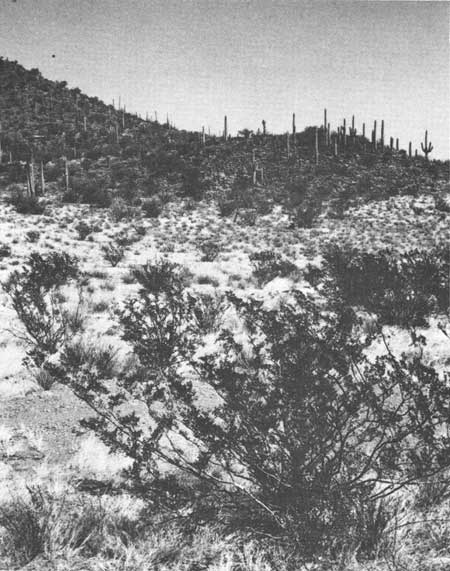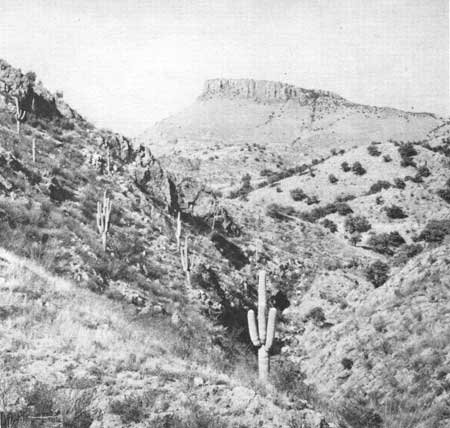|
SAGUARO
Ecology of the Saguaro: II NPS Scientific Monograph No. 8 |

|
CHAPTER 1:
INTRODUCTION (continued)
The Species
Distribution
The saguaro giant cactus is a drought-adapted, cold-intolerant, warm desert species that occurs throughout the length and breadth of most of the Sonoran Desert (Figs. 1, 3-12; Shreve 1951; Shreve and Wiggins 1964; Benson 1969; Hastings et al. 1972). Within that distribution, it grows primarily on the coarse soils of south-facing rocky slopes and adjoining bajadas4 and occurs sparsely or not at all on north-facing slopes or in the poorly aerated fine alluvial soils on the floor of the broad valleys that separate the characteristically discontinuous mountain ranges of the Basin-Range Province (Fig. 11).
4A bajada is the broad, gently sloping alluvial plain extending from the base of the mountains to the valley floor.

|
| Fig. 11A. Saguaros growing on a south-facing rocky slope 72 km (45 miles) west of Tucson, Arizona. Throughout the vast range of its distribution in the Sonoran Desert, the saguaro grows primarily on the coarse soils of south-facing rocky slopes and adjoining bajads. It occurs sparsely or not at all on north-facing slopes or in the poorly aerated, fine alluvial soils on the floor of the broad valleys that separate the characteristicaly discontinuous mountain ranges of the Basin and Range Province. Photographed 11 Feb. 1972. |

|
| Fig. 11B. Saguaro population west of Quijotoa (elev. 794 m; 2600 ft.) in south-central Pima County, Arizona. This population, growing nearer the geographic center of the species' distribution, exhibits a relatively well-balanced distribution of age-size classes. The relatively more stable age distribution of the population indicates less severe winter freeze-kill than at Tucson and Saguaro National Monument. The community is typical of the Arizona Upland subdivision of the Sonoran Desert (Shreve 1951), in which foothill paloverde (Cercidium microphylum), triangle bursage (Ambrosia deltoidea), ocotillo (Fouquieria splendens), jojoba (Simmondsia chinensis), and several chollas and prickly pears (Opuntia sp.) are conspicuous dominants. Photographed 11 Feb. 1972. |
At the southern limits of its distribution in southern Sonora, small disjunct populations occur on the basalt outcrops of hills (Fig. 12B). Disjunct populations also occur on rocky, south-facing slopes along the eastern and northern limits of its distribution in Sonora and Arizona (Fig. 12A). The Gulf of California marks the western limits of its distribution in Sonora (Fig. 9A). In southwestern Arizona and at the westernmost limits of its distribution in southeastern California within a few miles of the Colorado River near Blythe, sparse populations are directly associated with areas of concentrated runoff (Fig. 9A). The metropolis of the species population near the Arizona-Sonora border coincides more or less with the center of its geographic distribution (Fig. 11B).

|
| Fig. 12A. A small, isolated population of saguaros growing on a south-facing rocky slope near Ruby, Santa Cruz County, Arizona. Note oak-studded grassland on adjacent north-facing slope. Other small disjunct populations growing in topographically similar situations occur elsewhere along the northern and eastern boundaries of the species' distribution in Arizona and northern Sonora. Photographed 24 Mar. 1968. |

|
| Fig. 12B. In southern Sonora, at Cerro Masiaca (and Cerro Prieto, 48 km = 30 miles northward) small disjunct saguaro populations, at the southern limit of the saguaro's range, are limited to the basalt boulder-covered, south-facing slopes clothed with subtropical thornscrub vegetation. Young saguaros are found growing in the boulder patches. Photographed 27 Dec. 1974. |
Adaptive evolution and co-evolved species
The saguaro is one of a large group of tropically derived species of columnar cacti. Recent revision of the genus by Benson (1969) has been received with mixed reaction (see Felger 1970). The saguaro occurs only in the Sonoran Desert where it overlaps the distribution of four other closely related and ecologically similar species of columnar cacti: Cereus pecten-aboriginum, C. pringlei, C. schotti, and C. thurberi (Figs. 7-9). In South America, an evolutionary homolog of the saguaro, Trichocereus terscheki, occurs in the Monte of Argentina in a climate analogous to that of the Sonoran Desert.
Reported investigations on these co-evolved, warm-adapted species are few but significant in the relationship of those findings to a more complete understanding of the biology of the saguaro. Solbrig (1972) has reported on continuing investigations on the evolutionary significance of floristic disjunctions, between the Monte in Argentina and the Sonoran Desert in Mexico and the United States, that include columnar cacti. Felger and Lowe (1967) have described adaptive clinal variations in physical characteristics of the stems of the senita cactus (Cereus schotti).
McDonough (1963) has reported on phytosociological relationships of the organpipe cactus (Cereus thurberi) and compared germination responses (1964) with those of the saguaro.
Details on the physiological adaptations of the saguaro are little known. Soule and Lowe (1970) offer the only report on physiological adaptations of the saguaro to the environmental gradients within the geographic range of its distribution. They examined the relationship of differences in the osmotic potential of saguaro tissues to soil characteristics and climatic gradients over the range of the species in Sonora and Arizona.
Further studies on the adaptive mechanisms of the saguaro and other species of columnar cacti will certainly contribute to our knowledge of the ecology of each of these species, and to fuller understanding of the basic ecology of desert ecosystems.
| <<< Previous | <<< Contents >>> | Next >>> |
chap1a.htm
Last Updated: 21-Oct-2005